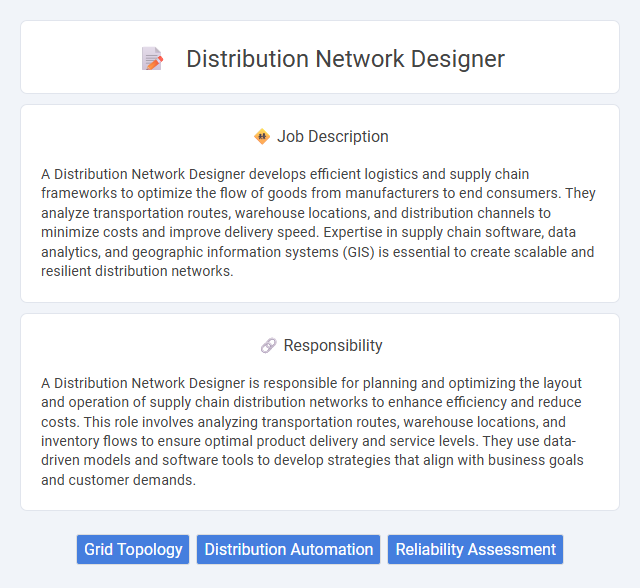
A Distribution Network Designer develops efficient logistics and supply chain frameworks to optimize the flow of goods from manufacturers to end consumers. They analyze transportation routes, warehouse locations, and distribution channels to minimize costs and improve delivery speed. Expertise in supply chain software, data analytics, and geographic information systems (GIS) is essential to create scalable and resilient distribution networks.
Individuals with strong analytical skills and a detail-oriented mindset are likely to be well-suited for a distribution network designer role. Those who enjoy problem-solving and working with complex logistical systems may find the job fulfilling and aligned with their strengths. People who prefer routine tasks or have limited interest in technical challenges might find the position less suitable.
Qualification
A Distribution Network Designer typically requires a bachelor's degree in electrical engineering, logistics, or supply chain management, with advanced certifications like Six Sigma or PMP enhancing job prospects. Proficiency in network modeling software such as AutoCAD, GIS, or PSS/E is essential for optimizing power and utility distribution systems. Strong analytical skills combined with experience in load forecasting and resource allocation ensure efficient and reliable network design implementation.
Responsibility
A Distribution Network Designer is responsible for planning and optimizing the layout and operation of supply chain distribution networks to enhance efficiency and reduce costs. This role involves analyzing transportation routes, warehouse locations, and inventory flows to ensure optimal product delivery and service levels. They use data-driven models and software tools to develop strategies that align with business goals and customer demands.
Benefit
Distribution network designer roles likely offer the benefit of optimizing supply chain efficiency, which can result in significant cost savings and improved service levels. Professionals in this position may experience enhanced problem-solving skills and strategic thinking due to the complexity of designing efficient distribution systems. There is a probable career advantage through exposure to advanced logistics technologies and data analytics tools, increasing marketability in the logistics and supply chain industry.
Challenge
A Distribution Network Designer likely faces challenges in balancing cost efficiency with service level requirements while adapting to changing market demands. Optimizing route planning and resource allocation may require advanced analytical skills to handle complex logistics scenarios and uncertainty. The role probably involves continuous problem-solving to improve network resilience and scalability amid evolving supply chain dynamics.
Career Advancement
Distribution network designers play a critical role in optimizing supply chain efficiency by developing and maintaining robust distribution systems. Career advancement in this field often leads to senior logistics management, supply chain strategy roles, or specialized positions in network optimization using advanced analytics and AI technologies. Mastery of distribution modeling software and a strong understanding of cost minimization and service level improvement are key factors driving upward mobility and higher earning potential.
Key Terms
Grid Topology
A Distribution Network Designer specializing in Grid Topology is responsible for planning and optimizing electrical distribution systems to enhance reliability and efficiency. They analyze load patterns, determine optimal feeder configurations, and create resilient grid structures such as radial, ring, or interconnected systems to minimize outages and voltage drops. Advanced software tools and geographic information systems (GIS) are utilized to model complex grid topologies and support decision-making for infrastructure upgrades and smart grid integration.
Distribution Automation
A Distribution Network Designer specializing in Distribution Automation develops and optimizes electrical distribution systems using advanced automation technologies such as SCADA, smart sensors, and intelligent electronic devices (IEDs). They analyze grid data to enhance reliability, reduce outages, and integrate renewable energy sources through automated switching and fault detection. Expertise in communication protocols and real-time monitoring tools enables the efficient design and implementation of smart grid solutions that improve energy efficiency and operational performance.
Reliability Assessment
A Distribution Network Designer specializing in Reliability Assessment analyzes power systems to identify vulnerabilities and enhance grid stability. They utilize predictive modeling and fault analysis to minimize outages and optimize maintenance schedules. Their expertise ensures continuous energy delivery by improving system resilience and reducing downtime in electrical distribution networks.
 kuljobs.com
kuljobs.com